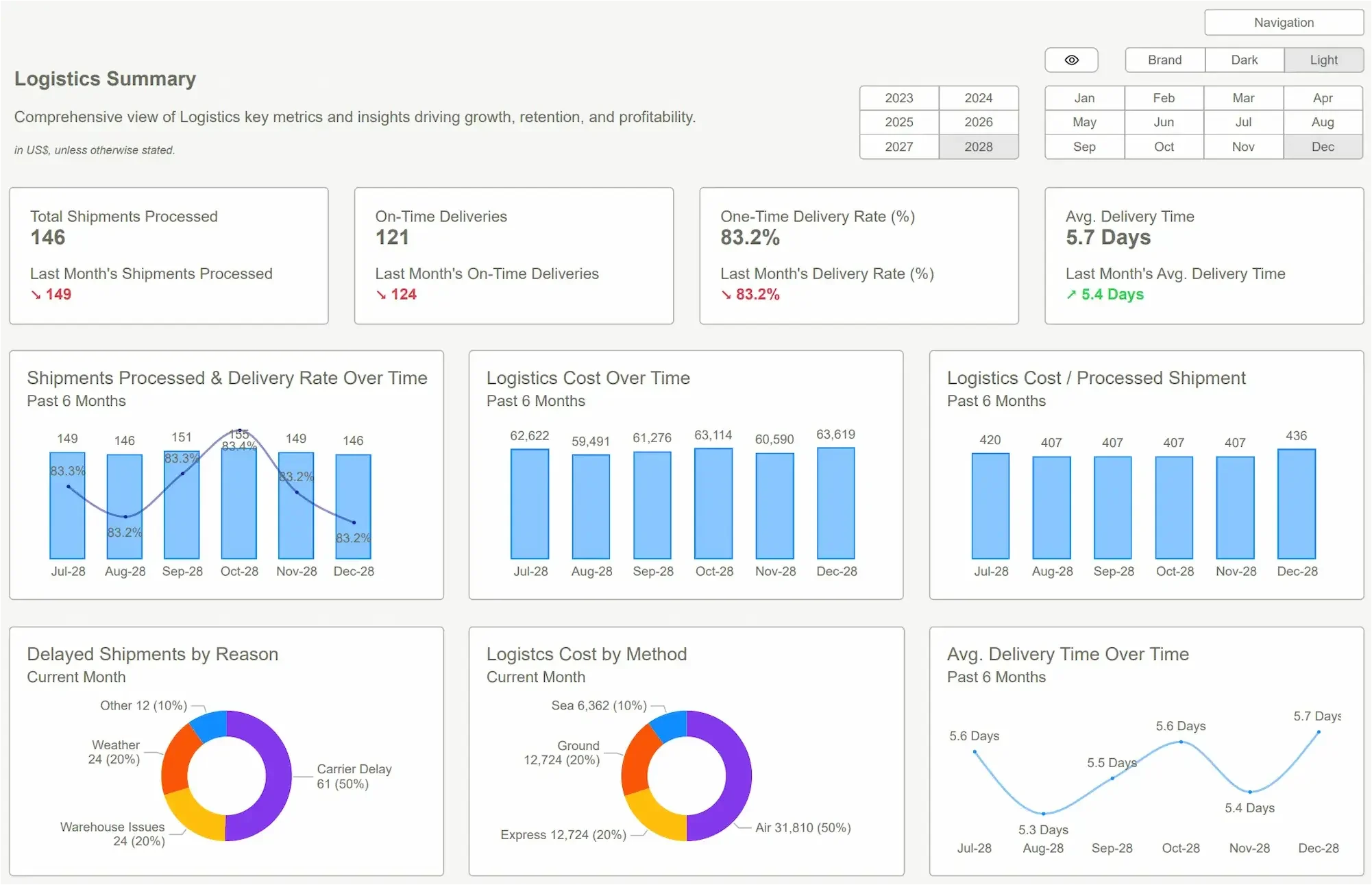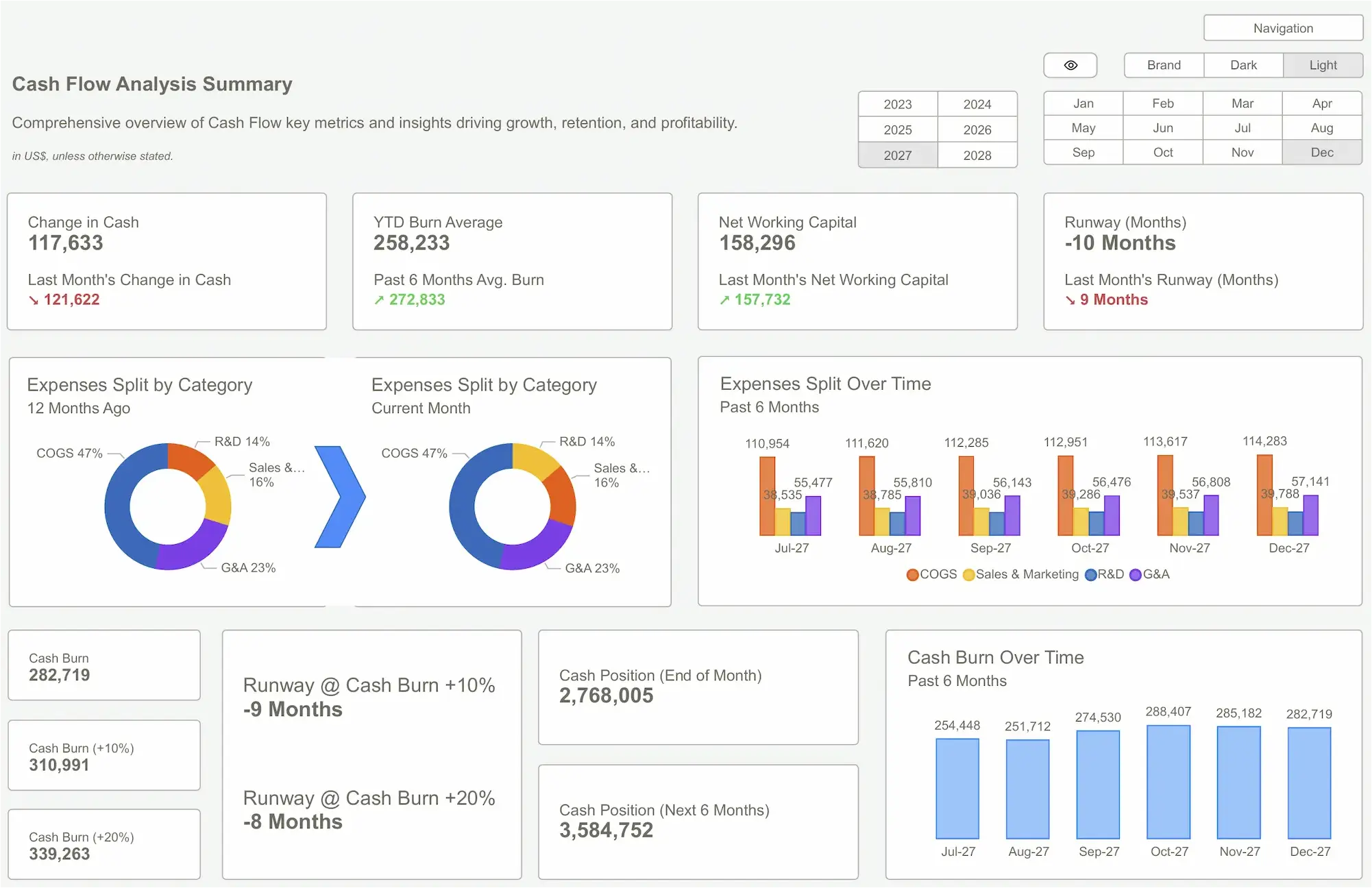Let’s be honest. Your financial model is probably a work of fiction.
It’s a beautifully formatted spreadsheet, sure. Maybe it even has a few pivot tables and some slick charts. But it’s brittle. It takes a week to update, and only one person on your team (the one you’re terrified will quit) knows how it really works. When a board member asks, “What happens to our runway if we hire five more engineers and churn increases by 10%?” you get a vague, hand-wavy answer.
This isn't a spreadsheet problem; it's a visibility problem. We once worked with a Series B company that looked fantastic on paper. Their model showed 18 months of runway. The reality? Disconnected data sources and bad assumptions were hiding a cash crisis. They had less than six months. The model wasn’t a tool for foresight; it was an instrument of self-deception.
Most startups are flying blind, making multi-million dollar decisions based on these glorified calculators. The goal of FP&A (Financial Planning & Analysis) isn't to create a perfect report. It's to build a machine for truth—a dynamic engine that connects your operations to your financial outcomes and lets you see the future before it happens.
Why Your Current “Model” Is a Ticking Time Bomb
The problem isn’t that your team is bad at Excel. The problem is a broken mindset that treats FP&A as a backward-looking reporting exercise instead of a forward-looking strategic weapon. This fundamental error is where the chaos begins.
Here are the signs you’re stuck in this trap:
- The "Sacred Spreadsheet": Your model lives in a single, monstrous file that everyone is afraid to touch. Any change risks a cascade of #REF! errors.
- The Monthly Fire Drill: “Updating the forecast” is a week-long manual slog of copy-pasting data from ten different sources. By the time it’s done, the information is already stale.
- It Can’t Answer “What If?”: Your model can tell you what happened last month, but it can’t reliably tell you what will happen next month if you pull a strategic lever. It’s a static photograph, not a dynamic simulation.
Most founders try to solve this with more tools—a new dashboard, a BI platform, or hiring a “finance person” to own the mess. But these are just symptoms. The real problem is a lack of connection between your business operations and your financial statements. You’re tracking CAC, LTV, and bookings in one system and revenue, expenses, and cash in another. They don’t talk to each other. So when your Head of Sales crushes their quota, you can’t see the downstream impact on cash flow, server costs, or your hiring plan for three weeks. That’s a lifetime for a startup.
 FP&A
FP&AThe Shift: From Static Reports to a Strategic GPS
To fix your FP&A, you don’t need a more complicated spreadsheet. You need a simpler, more powerful way of thinking. You need to stop reporting and start building a driver-based model.
Here’s the flawed assumption most companies operate under: financial history predicts financial future. They build forecasts by taking last month’s P&L and adding a growth percentage. It’s lazy and almost always wrong.
The smarter assumption is this: operational activity drives financial results.
Think of it like this: A traditional financial model is a paper map. It shows you where you’ve been, but it’s static and instantly outdated. A driver-based model is a GPS. It uses real-time inputs (your key operational metrics) to show you exactly where you are, where you’re headed, and allows you to instantly re-route based on new information. Want to see a different path? Change a driver and watch the entire journey update.
This is the “aha moment” for every executive team we work with. The Head of Marketing suddenly sees how their ad spend directly impacts the company’s cash runway. The Head of Product understands the financial trade-offs between two feature builds. The model stops being a document owned by finance and becomes a shared language for the entire leadership team to debate strategy and make smarter, faster decisions.
 Forensic Accounting: Your KPIs Are Lying
Forensic Accounting: Your KPIs Are LyingBuilding Your First Real FP&A Model: A 4-Step Takedown
Moving from spreadsheet chaos to strategic clarity isn't an overnight project, but the process is straightforward. It’s about focusing on what truly matters.
Before: A board meeting question about runway sends your finance lead into a two-day panic to remodel everything. Decisions are delayed. Confidence is shot.
After: You change two assumptions in a dropdown menu live in the meeting and see the impact on cash, hiring, and profitability in seconds.
Here’s how you get there:
- Isolate Your Core Business Drivers: Forget the 200-line P&L. What are the 5-10 operational metrics that actually drive your business? This could be new user signups, sales demos booked, average contract value, or customer support tickets. This is the bedrock of your model.
- Connect the Dots (The Data Bridge): This is where FP&A meets Data Analytics. You need to build reliable, automated data pipelines that feed your operational drivers into the financial model. No more manual exports. This ensures your model is a single source of truth, reflecting what's happening on the ground right now.
- Build the Three-Statement Model: With your drivers in place, you can now build a dynamic P&L, Balance Sheet, and Cash Flow Statement. The key is that they are outputs of your operational assumptions, not inputs. Change your customer acquisition cost, and watch your cash flow forecast update automatically.
- Automate & Stress-Test (The AI & Strategy Layer): This is where the model becomes a strategic weapon. You can build scenarios for best-case, worst-case, and fundraising models. This is also where AI consulting can add massive value, using predictive models to suggest more accurate driver forecasts or running thousands of simulations to identify hidden risks you hadn't considered.
 FP&A | Cube – Financial Reporting FP&A TopicsData Analytics Consulting
FP&A | Cube – Financial Reporting FP&A TopicsData Analytics ConsultingThe point of all this work isn't to get a perfect forecast. No model can predict the future. The point is to achieve strategic clarity. To build a system that replaces guessing with knowing, and slow deliberation with fast, data-backed decisions.
A robust FP&A process gives you more than a budget; it gives you control. It’s the difference between reacting to a cash crunch and seeing it coming three quarters away. It gives you the confidence to tell your board not just what you’re going to do, but why—and what the precise financial and operational impacts will be.
Most founders think they need more data or prettier dashboards. They don’t. They need a machine that turns operational inputs into financial truth. Building it is complex, but the first step is simple: deciding to stop flying blind.
Don’t wait for the fire. Know where the smoke is coming from.
When you're ready to stop guessing, we're ready to help.Get Started >
Ready to Unlock The Full Power of Clarity?
Explore our engagement options and pick the plan that fits your workflow.




